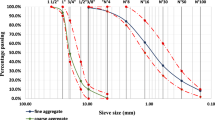Abstract
This study examines the influence of the physico-mechanical properties of the intact rock of aggregate materials on the strength performance of a concrete. For this aim, nine different aggregate types were produced from nine different intact rocks, and they were used in the production of nine different concretes. The physical and mechanical properties of the corresponding rocks were varied between 7.8 and 123.3 MPa, 13.30 and 26.40 kN/m3, 2.29 and 34.43%, and 1.30 and 4.34 km/s, for compressive strength (CSr), unit weight (UWr), porosity (nr), and ultrasonic pulse velocity (UPVr), respectively. During the making of the concretes, water–binder ratios were kept between 0.28 and 0.55 based on the slump and workability. According to 28-day compressive strengths, strong correlations were obtained from the physico-mechanical properties of the corresponding aggregate rocks and the compressive strength of the concretes (CSc). While the increasing the Young’s modulus (Er), CSr, UWr and UPVr of corresponding aggregate rocks increased the strength of concretes, the increase in the nr of corresponding aggregate rocks decreased the strength of concrete. The results obtained from this study indicated that knowing any physical or mechanical property of rock used for producing aggregate could be used to estimate the compressive strength of concrete.








Similar content being viewed by others
References
ACI Committee 221 (2001) Guide for use of normal weight aggregate in concrete, ACI manual of concrete practice: Part 1. Farmington Hills (MI)
Aitcin PC, Mehta PK (1990) Effect of coarse-aggregate characteristics on mechanical properties of high-strength concrete. ACI Mater J 87:103–107
ASTM (1991) American society for testing and materials, standard test method for pulse velocity though concrete, ASTM C 597-83. ASTM, West Conshohocken, PA
ASTM C 880-89 (1993) Standard test method for flexural strength of dimensional stone, Annual Book of ASTM Standards, vol 04.08. ASTM 1916 Race Street. Philadelphia, PA, pp 1103–1187
Beshr H, Almusallam AA, Maslehuddin M (2003) Effect of coarse aggregate quality on the mechanical properties of high strength concrete. Constr Build Mater 17:97–103
Davis DE, Alexander MG (1989) Properties of aggregate in concrete (part 1), Hippo Quarries Technical Publication Sandton, Hippo Quarrie
De Larrard F, Belloc A (1992) Are small aggregates really better for making high-strength concrete? Cem Concr Aggreg 14:62–66
ISRM (1981) Rock characterization, testing and monitoring. In: Brown ET (ed) ISRM (International Society for Rock Mechanics) suggested methods. Pergamon, Oxford
Kaplan MG (1986) Ultrasonic pulse velocity, dynamic modulus of elasticity, Poisson ratio, and strength of concrete made with thirteen different coarse aggregates, RILEM Bull, No 1, New Series, pp 17–28
Kewalrami MA, Gupta R (2006) Concrete compressive strength prediction using ultrasonic pulse velocity through artificial neural networks. Automat Constr 15:374–379
Kılıç A, Teymen A (2008) Determination of mechanical properties of rocks using simple methods. Bull Eng Geol Environ 67:237–244
Kılıç A, Atiş CD, Teymen A, Karahan O, Özcan F, Bilim C, Özdemir M (2008) The influence of aggregate type on the strength and abrasion resistance oh high strength concrete. Cem Concr Compos 30:290–296
Mehtra PK (1986) Concrete: structure, properties, and materials, 2nd edn. Prentice-Hall Inc., Englewood Cliffs
Neville AM (1981) Properties of concrete, 3rd edn. Longman Scientific, London, p 287
Neville AM (1995) Properties of concrete, 4th edn. Longman Group UK Limited Press, London
Özturan T, Çeçen C (1997) Effect of coarse aggregate type on mechanical properties of concretes with different strengths. Cem Concr Res 27:165–170
Sarıdemir M, Severcan MH, Çiflikli M, Acer Ş (2015) Evaluation of the relationships between the strength properties of HSC containing SF and GP at a low water–binder ratio. IJST-T Civ Eng 39(C2+):523–538
TS EN 12390-3:2009/AC (2002) Testing hardened concrete—part 3: compressive strength of test specimens. Turkish Standard Institution, Ankara
TS EN 12504-4 (2002) Testing concrete—part 4: determination of ultrasonic pulse velocity. Turkish Standard Institution, Ankara
TS EN 706 12620 + A1 (2009) Aggregates for concretes. Turkish Standard Institution, Ankara
Wu KR, Chen B, Yao W, Zhang D (2001) Effect of coarse aggregate type on mechanical properties of high-performance concrete. Cem Concr Res 31:1421–1425
Zhou FP, Lydon FD, Barr BIG (1995) Effect of coarse aggregate on elastic modulus and compressive strength of high performance concrete. Cem Concr Res 25:177–186
Zia P (1994) International workshop on high performance concrete, ACI SP-159, Detroit 215–223
Acknowledgements
The authors would like to thank to Scientific Research Projects Coordination Unit of Istanbul University for supporting this research (Project Number: 30744).
Author information
Authors and Affiliations
Corresponding author
Rights and permissions
About this article
Cite this article
Kılıç, A., Teymen, A., Özdemir, O. et al. Estimation of Compressive Strength of Concrete Using Physico-Mechanical Properties of Aggregate Rock. Iran J Sci Technol Trans Civ Eng 43 (Suppl 1), 171–178 (2019). https://doi.org/10.1007/s40996-018-0156-6
Received:
Accepted:
Published:
Issue Date:
DOI: https://doi.org/10.1007/s40996-018-0156-6




